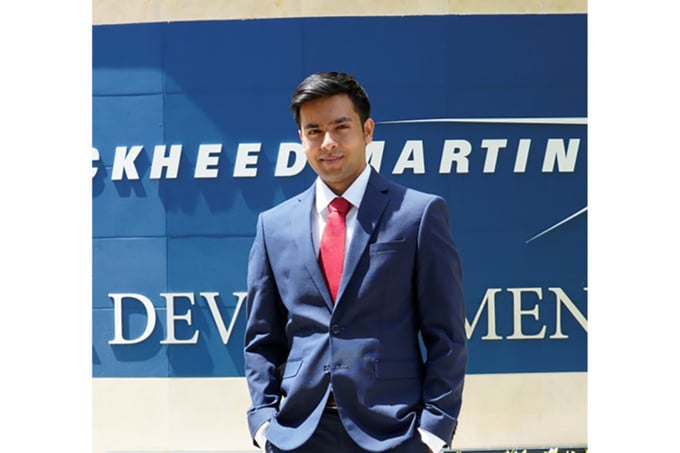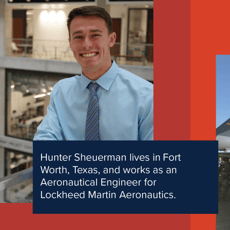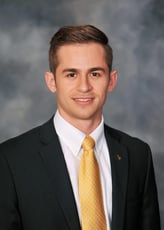For nearly 25 years, PLTW has offered transformative classroom and learning experiences for PreK-12 students. Now, many of those students are professionals in STEM fields. We recently reached out to several PLTW alumni to learn more about their educational and career journeys and find out what advice they have for current PLTW students. If you are a PLTW alumnus interested in sharing your story, we’d love to hear from you here.
Ace Chowdhury lives in Arlington, Texas, and works as an aeronautical engineer associate for Lockheed Martin. In high school, he completed PLTW Engineering’s Introduction to Engineering Design, Principles of Engineering, and Aerospace Engineering courses.
In what grades did you participate in PLTW? What were some of your most memorable experiences from PLTW?
I took PLTW courses during my freshman, sophomore, and senior years of high school. My favorite experiences always involved the group projects that we were tasked with because they allowed me to brainstorm and tackle challenges as a team.
For example, in Principles of Engineering, we were tasked with designing, building, and programming an autonomous robot. I not only got a chance to network with new friends and improve my communication skills, but also gained some leadership experience when I helped set up our group goals and team roles. The great part of the project was that, regardless of who acted as the “leader” on the team, we all worked together on every step of the design process. Furthermore, this project was memorable because we actually exceeded the project requirements by engaging in an extra credit challenge to make our robot follow a line around the entire classroom. The feeling of seeing our robot accomplish this after all the work we put in was truly priceless.
What did your journey look like to get to where you are today?
During my senior year of high school, I got accepted into our high school internship program. Through this program, I got the chance to intern at Lockheed Martin (Ft. Worth) with the Cybersecurity Engineering team during the school year. I also got a chance to intern there in the summer as a full-time intern.
However, as I planned to pursue a degree in mechanical engineering at the University of Texas at Arlington, I looked forward to branching out my internship experience to gain more relevant experience related to my field of study. After my sophomore year of college, I interned again at Lockheed Martin, but with the Air Vehicle Weapons team. This internship allowed me to practice using 3-D modeling software, particularly CATIA V5, and learn the process behind maintaining and managing external attachments to the aircraft (such pylons, payloads, and support equipment).
Then, in the summer after my junior year of college, I worked as a Flight Test Engineering intern for Lockheed Martin at Patuxent River, Maryland. For me, this was the most hands on internship I had ever had! I was tasked with designing a repair for one of the jets in the hangar. This required me to physically go and examine the issue on the jet, brainstorm solutions, design the repair in CATIA V5, communicate my proposed repair to the mechanics who were going to make the actual repair part, and ensure that all design and tooling specifications were met.
All in all, my internships with Lockheed Martin shaped my understanding of engineering in the real world and ultimately inspired me to promote STEM for the years to come!
What is your current role within your company? What are your responsibilities in this position?
I am currently working as an aeronautical engineer associate with the F-35 Inner Wing team, which is a part of the Airframe Design department. My responsibilities primarily consist of reviewing and revising design drawings (in CATIA V5). As I just started my full-time position this year, I also actively try to learn more about the processes and techniques that are involved when creating and reviewing the drawings. Enrolling in training courses and talking with experienced members of the team have definitely helped me learn and grow my knowledge of this department and engineering design in general.
What did you learn in PLTW that still helps you today?
As I mentioned before, the most valuable PLTW projects for me involved teamwork. Even in my professional career, working together with others has been crucial to not just completing my tasks/projects, but doing so in the most efficient and accurate way possible. The technical engineering knowledge gained through PLTW was also helpful, but I found that my experience working with others, sharing ideas, and communicating effectively was the most helpful skill I learned from my PLTW courses.
Do you have any advice for current PLTW students?
The best advice I would offer to current PLTW students is to learn as much as possible, but always to make sure to understand the “bigger picture” of the projects or tasks they engage in. Also, it is important to really be passionate about what you are doing and understand the impact STEM has on the world! Never be shy to ask about or show interest in any opportunities that present themselves (because that’s what makes the journey fun!).


